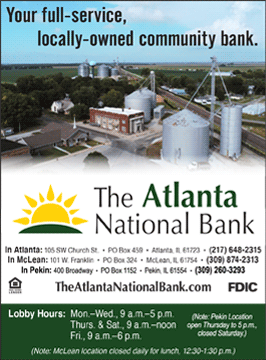The vast majority of US adults are stressed about grocery costs, an AP-NORC
poll finds
[August 05, 2025] By
CORA LEWIS and LINLEY SANDERS
NEW YORK (AP) — The vast majority of U.S. adults are at least somewhat
stressed about the cost of groceries, a new poll finds, as prices
continue to rise and concerns about the impact of President Donald
Trump's tariffs remain widespread.
About half of all Americans say the cost of groceries is a “major”
source of stress in their life right now, while 33% say it's a “minor”
source of stress, according to the poll from The Associated Press-NORC
Center for Public Affairs Research. Only 14% say it's not a source of
stress, underscoring the pervasive anxiety most Americans continue to
feel about the cost of everyday essentials.
Other financial stressors — like the cost of housing or the amount of
money in their bank accounts — are also broadly felt, but they weigh
more heavily on younger Americans, who are less likely than older adults
to have significant savings or own property.
The survey also found that about 4 in 10 Americans under age 45 say
they've used what are known as “buy now, pay later” services when
spending on entertainment or restaurant meals or when paying for
essentials like groceries or medical care.
Adam Bush, 19, based in Portland, New York, is one of those younger
Americans who has used pay-later services for things like groceries or
entertainment. Bush works as a welder, fabricating parts for trucks for
Toyota, and makes under $50,000 per year.
“I just keep watching the prices go up, so I’m looking for the cheapest
possible stuff,” he said. “Hot pockets and TV dinners.”

Everyone is stressed about groceries
Groceries are one of the most far-reaching financial stressors,
affecting the young and old alike, the poll finds. While Americans over
age 60 are less likely than younger people to feel major financial
anxiety about housing, their savings, child care, or credit card debt,
they are just as worried about the cost of groceries.
Esther Bland, 78, who lives in Buckley, Washington, said groceries are a
“minor” source of stress — but only because her local food banks fill
the gap. Bland relies on her Social Security and disability payments
each month to cover her rent and other expenses — such as veterinary
care for her dogs — in retirement, after decades working in an office
processing product orders.
“I have no savings,” she said. “I'm not sure what's going on politically
when it comes to the food banks, but if I lost that, groceries would
absolutely be a major source of stress.”
Bland's monthly income mainly goes toward her electric, water and cable
bills, she said, as well as care of her dogs and other household needs.
“Soap, paper towels, toilet paper. I buy gas at Costco, but we haven't
seen $3 a gallon here in a long time,” she said. “I stay home a lot. I
only put about 50 miles on my car a week.”
According to the poll, 64% of the lowest-income Americans — those who
have a household income of less than $30,000 a year — say the cost of
groceries is a “major” stressor. That's compared with about 4 in 10
Americans who have a household income of $100,000 or more.
But even within that higher-income group, only about 2 in 10 say grocery
costs aren't a worry at all.
Women and Hispanic adults are especially economically anxious
Housing is another substantial source of worry for U.S. adults — along
with their savings, their income and the cost of health care. About half
of U.S. adults say housing is a “major” source of stress, according to
the poll, while about 4 in 10 say that about the amount of money they
get paid, the amount of money they have saved and the cost of health
care.
[to top of second column] |

A customer buys Chinese made ginger candy at 99 Ranch Market, an
Asian grocery store in Los Angeles, April 7, 2025. (AP Photo/Damian
Dovarganes, File)
 About 3 in 10 say credit card debt
is a “major” source of stress, while about 2 in 10 say that about
the cost of child care and student debt.
But some groups are feeling much more anxiety about their finances
than others. Women, for instance, are more likely than men to report
high levels of stress about their income, savings, the cost of
groceries and the cost of health care. Hispanic adults are also
particularly concerned about housing costs and both credit card and
student debt. About two-thirds of Hispanic adults say the cost of
housing is a “major” source of stress, compared with about half of
Black adults and about 4 in 10 white adults.
Some people are making changes to their lifestyle as a result of
high costs. Shandal LeSure, 43, who works as a receptionist for a
rehabilitation hospital in Chattanooga, Tennessee, and makes between
$85,000 and $100,000 a year, said she's started shopping for
groceries at less expensive stores.
“It's an adjustment,” she said. “Sometimes the quality isn't as
good.”
Many US adults have used ‘buy now, pay later’ services
As they stretch limited budgets, about 3 in 10 U.S. adults overall
say they've used “buy now, pay later” services such as Afterpay or
Klarna to purchase groceries, entertainment, restaurant meals or
meal delivery, or medical or dental care, according to the poll.
Bland, the Washington state retiree, said she’s paid for pet surgery
with a pay-later plan.
Younger Americans are much likelier than older people to have used
pay-later plans for entertainment, groceries or restaurant meals,
but there's no age gap on medical care. Black and Hispanic people
are also especially likely to adopt the plans.
An increasing share of “buy now, pay later” customers are having
trouble repaying their loans, according to recent disclosures from
the lenders. The loans are marketed as a safer alternative to
traditional credit cards, but there are risks, including a lack of
federal oversight. Some consumer watchdogs also say the plans lead
consumers to overextend themselves financially.

LeSure said she’s used pay-later services for things like new
clothes, while she balances debt payments for a car loan, student
loans and medical bills. She's also turned to them to cover hotel
costs after being evicted.
“That’s been able to help me stretch my dollar,” she said.
___
Sanders reported from Washington.
___
The AP-NORC poll of 1,437 adults was conducted July 10-14, using a
sample drawn from NORC’s probability-based AmeriSpeak Panel, which
is designed to be representative of the U.S. population. The margin
of sampling error for adults overall is plus or minus 3.6 percentage
points.
All contents © copyright 2025 Associated Press. All rights reserved |